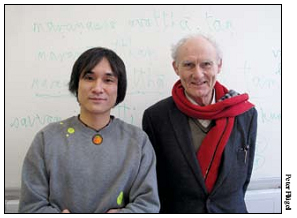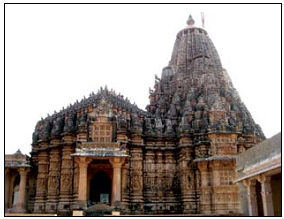
Centre of Jaina Studies Newsletter: SOAS - University of London
Taking the Prakrit courses at SOAS, comprising two half units, 'Introduction to Prakrit' and 'Readings in Prakrit', has been a great learning experience in this academic year. The first term is designed essentially to furnish students with the basic rules of Prakrit grammar in association with translation exercises between Prakrit and English in both ways. Historical backgrounds of both the language and its literature are also treated in the first term. Among various Prakrit dialects belonging to the Middle Indo-Aryan, in different times and places, Jain Maharashtri has been chosen as the medium of our study for practical reasons; but SOAS Prakrit students will also be exposed to other variant forms of the language through reading selected passages from Maṇipaticarita (in both the classical Maharashtri and old Magadhi) and Brahmi inscriptions such as the Girnar version of Aśoka's Rock Edict XI (in Girnar Western Prakrit) and Kharoshthi inscriptions from the Taxila Vase (in Gandhari Prakrit). Following the conventions, the Roman alphabet rather than Devanagari script is employed in the course to reproduce Prakrit sounds. Nevertheless, a brief introduction to Brahmi and Kharoshthi scripts is given before reading these early inscriptions.
Taking the Prakrit courses at SOAS, comprising two half units, 'Introduction to Prakrit' and 'Readings in Prakrit', has been a great learning experience in this academic year. The first term is designed essentially to furnish students with the basic rules of Prakrit grammar in association with translation exercises between Prakrit and English in both ways. Historical backgrounds of both the language and its literature are also treated in the first term. Among various Prakrit dialects belonging to the Middle Indo-Aryan, in different times and places, Jain Maharashtri has been chosen as the medium of our study for practical reasons; but SOAS Prakrit students will also be exposed to other variant forms of the language through reading selected passages from Maṇipaticarita (in both the classical Maharashtri and old Magadhi) and Brahmi inscriptions such as the Girnar version of Aśoka's Rock Edict XI (in Girnar Western Prakrit) and Kharoshthi inscriptions from the Taxila Vase (in Gandhari Prakrit). Following the conventions, the Roman alphabet rather than Devanagari script is employed in the course to reproduce Prakrit sounds. Nevertheless, a brief introduction to Brahmi and Kharoshthi scripts is given before reading these early inscriptions.
The Prakrit class of this academic year (2009/10) has a good mixture of students and academic members of SOAS, all having a keen interest in Prakrit. Each of us seems to have a different intention in taking the course, according to our main areas of Indological study. As a student in the Department of Art & Archaeology, I have joined the course as a result of my special concerns about epigraphy and paleography, while others specialize in Sanskrit, Jaina or other religious studies, or textual histories of India. The SOAS Prakrit course actually comes in handy for any prospective learner, to a great extent, mainly because it does not require any previous knowledge of Sanskrit and Pali or any other pre-modern IndoAryan language, or Devanagari script. Another reason is that Prakrit grammar is simpler than that of Sanskrit in many ways. Even for students of Sanskrit like me, Prakrit sometimes increases our understanding of the former by providing a basis for comparison.

Professor J. Clifford Wright and the author
One, however, still needs to overcome certain difficulties in memorizing vocabulary and paradigms like any other new language to be learned. In spite of our helping each other to cope with our own individual weak points, we principally have the immense support of our teacher, Emeritus Professor J. Clifford Wright with his wide expertise in Vedic, Classical Sanskrit, Pali and Prakrit language and literature as well as comparative philology. Questions sometimes occur even for vocabulary not only when one word has a few different meanings, but also when more than one word refers to the same meaning, i.e. synonyms. I learned from Professor Wright, who has also been editing a dictionary of the Indo-Aryan languages, that as for sarīro (m.) and tanū (f.), both meaning 'body', the former is 'the physical body' (as opposed to mind) and the latter is more like a 'person' (sayā tanū 'myself'); a god has a tanū, you too can achieve a heavenly tanū, but only a sādhu can leave his sarīro without dying.
The Prakrit experience at SOAS has certainly enhanced my enthusiasm for Jainism, which was rather inescapable in Gujarat where I spent two gap years for my fieldwork for a project on documenting the Buddhist remains there. In the course of my fieldwork, I could not ignore the historical or current presence of Jains at quite a few key Buddhist sites as well as their influences on Buddhist art. In the case of Gujarat, it seems that the Prakrit tool is especially effective for this purpose especially from the Mauryan to Solaṅkī periods. I used the Jaina reference Kumārapāla-pratibodha of Somaprabhācārya from the 12th century CE, written in Apabhraṃśa, the latest of the Prakrit dialects. In the story of Khapuṭācārya therein, his source referring to the past states that Vatsaraja, the Buddhist king, built a temple for the Buddhist deity Tārā but he was later converted to Jainism (presumably not completely so). It clearly shows the compatibility between the two religions as well as the presence of Tārā worship in northern Gujarat. After the completion of my Prakrit course, I plan to go through the text in the original to know the religious climate of the Solaṅkī period especially in the Jaina context. As the iconography was complex, so the religion itself might have been. Or otherwise, the Jaina influences may be due to the workshop or the artist's hand, familiar with the Jaina form of art. Learning Prakrit also encourages my interest in the modern Indian language. As a Hindi learner at an elementary level, I cannot ignore certain Prakrit legacies in it. The personal pronoun 'ta' meaning 'that, he, it' in Prakrit has its neuter ablative forms as the indeclinable, 'tao' and 'to' meaning 'hence, then'. The latter is identical in Hindi in its form and meaning. The use of a participle for perfective tense and its difference in construction between transitive and intransitive verbs are also similarities shared by both languages. We learned in the class that Hindi, Gujarati and Sinhalese can be seen as descendants of distinct Prakrit languages. Over all, in the history of language, Prakrit illustrates the link between the Old Indo-Aryan and the modern Indian languages, and it has widely contributed to the Indian culture in many aspects.
There already have been applications of my immature Prakrit knowledge to my studies in Art & Archaeology, and I look forward to continuing the course.

The Ajitanātha Jaina temple, built by Kumārapāla in the Solaṅkī period, as it appeared before the recent painting of the exterior. (Tāraṅgā Hill, north Gujarat, 2007). Photo: Ken Ishikawa
Ken Ishikawa is a BA South Asian Studies (Sanskrit/ Prakrit/Hindi) student in the Department of Art & Archaeology at SOAS. His research centres on Indic art history, especially of Gujarat.